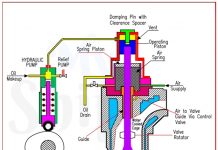
Q. Explain the associated key factors and activities to ensure successful Planned Maintenance program onboard ships under ISM codes with the following terms
a. Corrective action process
b. Developing and improving maintenance procedures.
c. Systematic approach to maintenance
d. Maintenance intervals
e. Inspections
Answer:-
The ISM code is intended to improve the safety of shipping and to reduce pollution from ships by impacting the way the shipping companies are managed and operated Element 10 of ISM code:
MAINTENANCE OF SHIP AND EQUIPMENT
The Company should establish procedures to ensure that ship is maintained to confirm with the provisions of relevant rules and regulations and with any additional requirements which may be established by the company.
10.2 – In meeting these requirements the company should ensure that
- inspections held at appropriate intervals
- any non-conformity is reported with its possible cause
- appropriate corrective action taken and,
- records of these activities are maintained
10.3 – The Company should establish procedures in its safety management system to identify equipment and technical systems the sudden operational failure of which may result in hazardous situations. The SMS should provide for specific measures aimed at promoting the reliability of such equipment or systems. These measures should include the regular testing of standby arrangements and equipment or technical systems that are not in continuous use.
10.4 – (PMS): The inspections and measures should be integrated into ship’s operational maintenance routine procedures based on relevant conventions, flag state instructions, classification society’s guidance and company policy. The associated key factors and activities to ensure successful PMS on board ship under ISM with following terms:
1. Corrective action process:
a) Chapter 9 of ISM code requires the company’s SMS to include:
I. Reporting and analysis of accidents, following the ISM audit
II. non-conformities are identified.
III. The company is responsible to determine and initiate the corrective action needed to correct a non-conformity or;
IV. to correct the cause of the non-conformity,
V. to improve safety and establish a procedure for implementation of corrective action to prevent reoccurrence.
b) Failure to correct the non-conformity with specific requirements of the ISM code within the stipulated time period may affect the validity of the DOC and related SMC’s issued to the vessel. Corrective action and possible subsequent follow up audits should be completed.
c) Depending on the nature and degree of non-conformity the master and ship staff to take corrective action by eliminating the cause of it.
d) Corrective action processes such as root cause analysis help identify and eliminate the underlying reasons causing machinery failure, thereby preventing recurrence.
e) Element 4 of ISM code ensures that designated person ashore provide a link between company and those on board, ensuring adequate resources and shore support.
f) Corrective action process can be shown in following flow chart:

2. Systematic approach of maintenance:
a) Systematic approach to maintenance should be based on relevant conventions, flag state rules, classification society requirements and company policy.
b) A systematic approach to maintenance should include:
I. Equipment manufacturer’s recommendations, procedures and time intervals between o-hauls.
II. Condition monitoring equipment and routine maintenance.
III. The establishment of maintenance interval.
IV. The method and frequency of inspection.
V. Assignment of responsibility for inspection activities to appropriately qualified personnel.
VI. Availability of spares
VII. Age of ship, equipment and condition.
VIII. Risk analysis.
IX. Results of third party inspection.
X. Related ISM procedures
XI. Clear definition of reporting requirements and mechanisms.
3. Developing and improving maintenance procedures:
a) With the improvement in technology and practical experience now some classification societies allow condition based monitoring as a tool for maintenance over routine maintenance based on time interval, running hours etc.
b) Basis for this condition monitoring system is:
I. Continuous monitoring of data.
II. Data collection.
III. Recording and analysing the trend over a period of time.
IV. This has to be approved by class and it might request the data relating to concerned equipment to be send every month or once in 3 months for analysis.
V. This development of maintenance has led to increased intervals between o-hauls reduced maintenance work on ship staff etc.
c) Maintenance related deficiencies are to be identified and corrective action need to be taken. Preventive action will be by modifying the procedure of maintenance and by reviewing the SMS concerning the same.
d) The cumulative effect of identifying the non-conformity corrective actions and preventive actions will help in developing and improving the maintenance procedures.
4. Maintenance Intervals: Should be based on the following:
a) Manufacturers recommendations and specifications.
b) Predictive maintenance determination techniques (Lube oil analysis, vibration analysis).
c) Practical experience in operation and maintenance of ship and its machinery.
d) Historical trends in the results of the routine inspections and in nature and rate of failures.
e) The use to which the equipment is put continuous, intermittent, stand by or emergency.
f) Practical and operational restrictions e.g. inspection that can be only performed in d/dock.
g) Intervals specified as part of class, convention, administration and company requirements.
h) The need for regular testing of S/B arrangement.
5. Inspection:
a) Element 10.2.1 of ISM code requires inspection to be carried out at appropriate intervals to ensure conformance to regulations.
b) Routine inspection to be carried out to assess the performance of the equipment and its operational readiness for the intended purposes.
c) Same is to documented as per element 11 of ISM code.
d) Procedure for planned inspection routines should be written to include the following.
I. Acceptance Criteria.
II. Use of suitable measuring and testing equipment.
III. Calibration of measuring and testing equipment.
e) Examples of inspection and test that may be employed.
I. Visual.
II. Vibration.
III. Pressure.
IV. Temperature.
V. Electrical.
VI. Load.
VII. Water Tightness.
VIII. Inspection methods:
6. Sometimes checklist should be developed to assure that inspection, test & maintenance are performed according to the procedures, & at the specified intervals. These checklists can be developed from manufacturer‘s recommendation or specifications.



